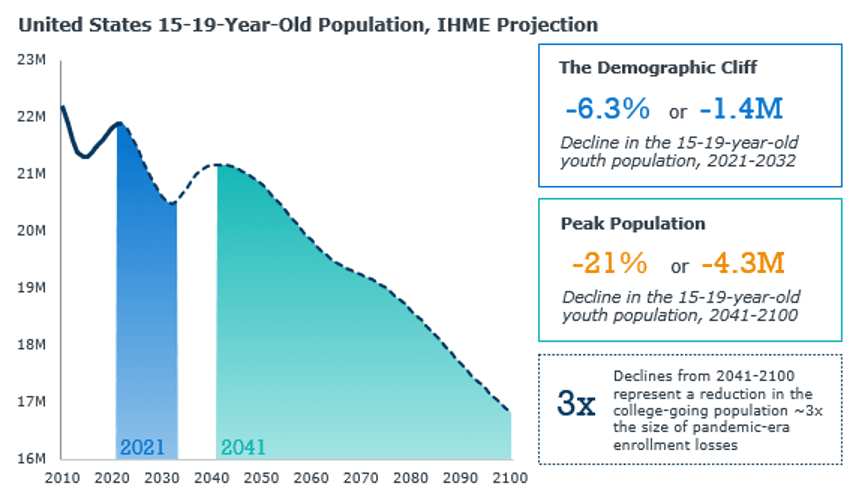6 community college trends to watch in 2025
After a challenging few years, community colleges celebrated a comeback in 2024 with notable gains in enrollment, retention, and persistence rates. Enrollment has increased by over 4%, freshman enrollment is up over 6%, and dual enrollment continues to grow. Retention and persistence rates are back to pre-pandemic levels, with students under the age of 24 actually showing modest increases in these areas.
These successes are worth celebrating, especially as students and institutions have navigated long-standing barriers to achievement—such as food insecurity, talent shortages, and unpredictable budgets—while also preparing for emerging challenges like widening gaps in student readiness and increasing demand for mental health resources.
To maintain this forward momentum, community colleges must stay ahead of key trends that could impact the sector, both positively and negatively, in 2025. Here are six trends to watch closely in the new year.
Trend 1: Younger students are embracing short-term credentials
Community colleges experienced a 10.3% growth in credentials awarded in spring 2024 compared to the previous year, reflecting increasing student interest in short-term, career-focused pathways. While short-term credentials have traditionally been viewed as more suited for adult learners, recent data shows younger students are embracing these opportunities as well. This supports the viewpoint that the notion of “adult learners” is broader than age: students of all ages may have conditions, like work and parenting, that influence their decision making when choosing a program.
In fact, during the 2022-23 academic year, learners aged 18 to 20 led all other age groups in certificate completion—an 11% increase from the previous year. This shift aligns with growing public skepticism of the traditional four-year college route, highlighting an opportunity for community colleges to capitalize on the rising demand for faster, more direct pathways to career success.
One important consideration is how to guide prospective students in selecting the path that best aligns with their goals, whether that’s a transfer pathway, a career-focused degree, or a non-credit option. A “one front door” admissions approach, where all students enter the college through the same admission touchpoints, enables them to explore the full range of options, including short-term and non-credit programs.
At Germanna Community College, students pursuing vocational training or short-term career credentials often felt disconnected from the broader campus community, limiting their access to vital services like advising and tutoring. To address this, the college recognized the need for a standardized onboarding process that offered a unified entry point and streamlined access to support services throughout each student’s journey.
Trend 2: FAFSA growing pains could persist
The 2023-24 FAFSA rollout faced delays and significant changes, leading to widespread confusion for students, families, and colleges. Launching in December 2023—two months later than usual—compressed financial aid timelines and strained institutional resources, especially at community colleges serving under-resourced populations. As a result, FAFSA completion rates for the Class of 2024 dropped by 11.6%.
While the 2024-25 rollout is expected to be smoother than the prior year, some students and families may have lingering distrust toward the process. The delay also shortens the time financial aid offices have to assist students with completing their submissions. This is particularly challenging for community college students, many of whom face complex life circumstances that can make the FAFSA process more difficult. In 2025, institutions need to be thoughtful about how their financial aid offices can communicate with students rapidly, and at scale, about incomplete FAFSAs, verification documents, and opportunities for one-on-one support.
To support students who started but didn’t complete their FAFSA, Holyoke Community College’s financial aid department used Navigate360 to send alerts, launch messaging campaigns, and enable students to schedule appointments with financial aid counselors for personalized guidance.
Read more about how HCC increased their FAFSA completion rate by 14%
Trend 3: Dual enrollment is accelerating—and now we have better national data
Community colleges have long been leaders in dual enrollment, with these programs now accounting for 21% of two-year college enrollment nationally. After years of stagnant enrollment among students aged 17 and under, 2023
For years, dual enrollment trends at the national level were measured by tracking students under the age of 17. In the coming years, an important development to watch is the new dual enrollment data being collected by the U.S. Department of Education. Recently, the department released groundbreaking information that, for the first time, offers college-level insights into dual enrollment participation.
This new dataset enables community college leaders to analyze state and institutional-level trends, offering a clearer picture of how dual enrollment is evolving. As this data continues to be collected, it will allow for more effective year-over-year comparisons.
Looking ahead to 2025, community colleges must focus on sustaining and building upon this growth. Key priorities include allocating resources to support dual enrollment expansion, forming strong partnerships with school districts for data sharing and early admissions strategies, and creating pathways that link dual enrollment to future career opportunities. Equally important is the need to establish bridges that encourage dual enrollment students to continue as degree-seeking students after high school.
Read more about how dual enrollment can help you reach your enrollment goals
Trend 4: AI is here to stay, and student success teams are eager to adopt it
AI is already shaping industries, workplaces, and education. For community colleges to remain relevant and prepare their students for the future, embracing AI is essential. Not only should campuses integrate AI tools to streamline administrative processes and enhance teaching, but they must also equip students with the skills to use AI effectively in their own careers.
Businesses across sectors are increasingly looking for employees who can harness AI to solve problems and innovate. By incorporating AI into curricula and offering training on its use, community colleges will help students stay competitive and adaptable in an evolving job market. According to recent studies, 73% of employers agree that AI skills are vital for future job prospects, and 85% of high-demand roles will require AI proficiency. Community colleges should begin to partner with employers and watch industry trends to understand what types of AI literacy students need and how it can be folded into classroom offerings.
There’s also the question of how community colleges use AI internally to build efficiency and stay on pace with other industries. A recent EAB survey reveals that while 69% of student success staff have used AI in the past year, 70% of colleges rarely or never track how their teams are using it, and 59% haven’t established a formal stance on AI. This enthusiasm among staff to experiment with new technologies is promising and presents a valuable opportunity for community colleges. By exploring AI tools and providing targeted training, institutions can enhance efficiency and help reduce staff stress, paving the way for more effective student support.
Click here to request a demo of EAB’s AI-powered solutions for community colleges
Trend 5: Enrollment is stabilizing, but still requires focus
Many enrollment leaders at community colleges are breathing a well-earned sigh of relief as enrollment stabilizes post pandemic. In 2024, two-year colleges saw a 4.7% increase in enrollment—the largest growth among all sectors. While dual enrollment contributed significantly, enrollment among students aged 30+ grew by 4.3%, and total freshman enrollment surged by 6.2%. In other words, community colleges are winning back students post pandemic and should put strategies in place to keep this momentum. This can include streamlining enrollment processes, building strong dual enrollment pathways, and continuing to examine what is bringing older students back to campus.
Maintaining this momentum is crucial because, while enrollment is recovering in the short term, long-term challenges lie ahead as the national population continues to shrink.

Source: “Global Burdens of Disease Population Projections 2019-2100,” Institute for Health Metrics and Evaluation; EAB interviews and analysis
We’ve been discussing the “demographic cliff” in higher education for over a decade, and now we’re standing on its edge. Youth populations are projected to decline by more than 6% by 2032. However, forward-thinking community colleges are already considering the implications of peak population, expected to hit the United States around 2060, and the long-term impact of a sustained population decline. If the near-term feels like looking over a demographic cliff, 2041 resembles staring down a demographic Mount Everest with no visible bottom.
Although the full effects may not be felt in 2025, this period of rebounding enrollment offers the ideal opportunity for institutions to plan ahead and adapt to upcoming demographic shifts.
As the population shrinks, competition for students will intensify, making student engagement even more critical. Institutions across sectors are likely to adopt increasingly competitive tactics to attract prospective students. In this environment, community colleges must take a hard look at their recruitment and communication strategies to ensure they understand who their prospective students are and that they are connecting with them in a personalized way.
Trend 6: Trump administration could bring changes
As with every presidential transition, a second Trump administration could bring significant changes to higher education, with community colleges likely to feel the impact. Among the most significant proposals is the potential elimination of the Department of Education, a move that could decentralize accreditation, transfer of oversight for financial aid programs like Pell Grants to the Treasury Department, and potentially disrupt aid delivery for low-income students.
The administration’s criticism of diversity, equity, and inclusion (DEI) programs could also reshape campus environments. Reduced funding and support for DEI initiatives may challenge colleges’ ability to recruit and retain diverse student populations and complicate efforts to create inclusive communities. Additionally, reversing Biden-era policies—such as student loan forgiveness and protections for transgender students under Title IX—could leave colleges grappling with how to support students amid shifting federal mandates.
Lastly, undocumented students, including those protected under the Deferred Action for Childhood Arrivals (DACA) program, could face renewed uncertainty. Previous efforts to terminate DACA indicate that access to education and work permits for these students could once again come under debate. However, recent signals from the Trump administration suggest a possible willingness to reconsider its earlier stance on DACA. Community college leaders should monitor national conversations about DACA because changes to the program could significantly impact the access, enrollment, and success of undocumented students in their institutions.
These shifts would impact both public policy and campus culture, placing pressure on community colleges to adapt quickly to a new, more conservative landscape. Going into 2025, community colleges need to consider what these shifts could mean for how their campuses operate and what resources are available to students.
Equip your team for the future of community college student success
New threats to community college enrollment and retention can be manageable with proactive interventions, strong data insights, and a strong value proposition to learners. To learn more about how EAB’s Navigate360 can assist with creating streamlined student success interventions and manage prospective student communications, fill out the form below.

More Blogs

The real demographic crisis isn't national—it's regional

How AI-powered ad filters are disrupting enrollment marketing campaigns
